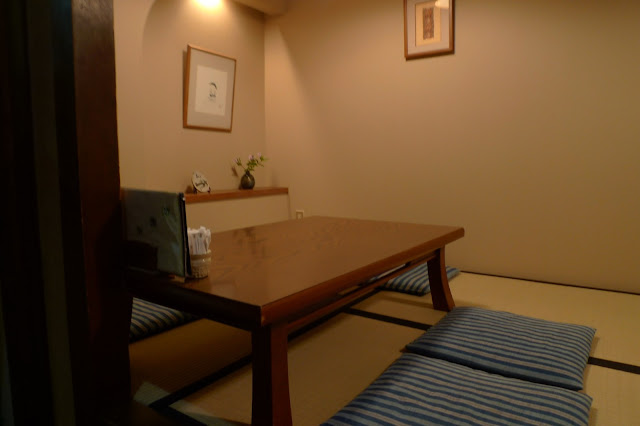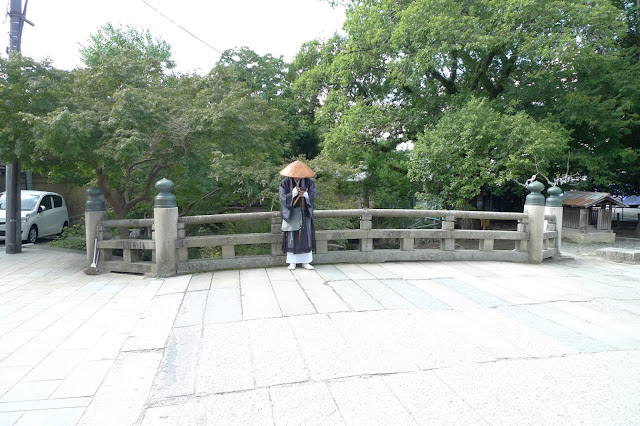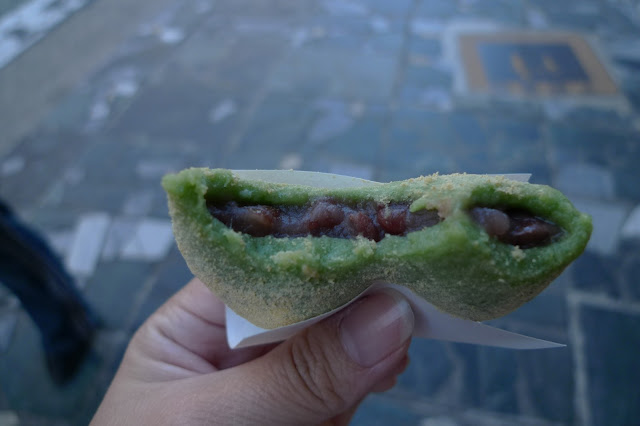Our day began at 8am and we will be checking out and heading to Nara with our luggages. Nara is served by JR and Kintetsu railway and is an hour away from Osaka and Kyoto. Nara Kintetsu station is minutes away from Kofukuji and other attractions whereas JR Nara is 20min walk away and is connected to Nara Kintetsu station by Nara Kotsu Bus service (Every 30min from 9am – 4.30pm at flat fare of ¥180). I decided to take JR train from Shinimamiya to Tsuruhashi and change to Kintetsu line since it's more convenient to stop at Nara Kintetsu station.
Tsutenkaku Tower
Nara was the first permanent capital of Japan but was later moved to Nagoya as the powerful monasteries grew to become a threat to the government. Nara is overshadowed by it's more famous neighbour, Kyoto and is frequently omitted from time-pressed tourists. I decided to include Nara since it is doable as a day trip. What attracts me here are the Todaji temple (largest wooden temple) and deer park.
Nara Kintetsu railway station is link to Higashimuki Shopping arcade and there are many shops and restaurant here. When we arrived at 9.30am, a lot of shops are not open yet.
Nara Kintetsu railway station
Nara Kintetsu railway station is link to Higashimuki Shopping arcade and there are many shops and restaurant here. When we arrived at 9.30am, a lot of shops are not open yet.
Entrance to Higashimuki Shopping arcade
Higashimuki Shopping arcade
Kofukuji temple 興福寺 is a Buddhist temple and was built in 669. There are several buildings in the compound and admission is free except Kofukuji's Treasure House (¥500) and the Eastern Golden Hall (¥300).
The Five storey pagoda is 50.1m tall and is Japan's second tallest, just 7m shorter than the Five Storey pagoda at Kyoto's Toji Temple.
Five Storey Pagoda
Eastern Golden Hall
Nan'endō (South octagonal hall)
Nine storey stone pagoda at Sarusawaike pond
Sarusawaike pond 猿沢の池
Next we walked to Naramachi Koshi-no-ie Residence ならまち格子の家. We have some problem finding Koshi-no-ie Residence and seek help from the locals. One helpful local told us in simple English "right-left-left-right" and bingo, we found the location.
Naramachi 奈良町
Altar along the street
Anyone knows what is the purpose of the garlic?
Koshi-no-ie Residence ならまち格子の家 is a former merchant home that is open to the public. It is one of Nara's traditional machiya townhouses with a shop space in the front of the building and the living quarters in the rear. Opening hours: 9am - 5pm and admission is free.
Koshi-no-ie Residence
We meet a Japanese old lady again whom we encountered when finding Koshi-no-ie Residence. She is still searching for Koshi-no-ie Residence. Hence Fredrick's mom asked Fredrick to guide her there while we waited for him.
Goryo Jinja shrine 御霊神社
Ringing the bell for prayers
Japanese wearing kimonos
Gangoji (元興寺)
Ruins left
I used to play with the seeds of this plant when I return to Labis during my childhood days as the seeds contains powder.
Powder plant
It's almost 11.30am and we decided to have our lunch. I have done research that kakinoha sushi is a local food in Nara. Kakinoha sushi (柿の葉ずし) is sushi (usually mackerel and/or salmon) wrapped in persimmon leaves. One of the restaurant selling this is Hiraso (平宗) Address: 30-1 Imamikado-cho (south of Sarusawa Pond 猿沢の池), Opening hours: 10am – 8pm, closed on Mon.
Hiraso (平宗)
Model of Kakinoha sushi
Tatami dining setting
Hot tea and hot towel are served
All of us except Fredrick's aunt ordered the noodle set which cost 1,200 ~ S$19. The noodle set consist of tofu, tempura, noodle and kakinoha sushi (one with salmon and the other with mackerel).
Noodle set
Kakinoha sushi
After our lunch, we continue to Todaji temple. Todaji temple is about 30min walking distance from Sarusawaike Pond. On the way, we saw a lot of deers roaming around and they seem to be tame.
According to the legendary history of Kasuga Shrine, a mythological god Takemikazuchi arrived in Nara on a white deer to guard the newly built capital of Heijō-kyō. Since then the deer have been regarded as heavenly animals, protecting the city and the country.
Beware of deers
Ricksaw
I wonder what are these people queueing for
Is this deer boarding the cab?
Shops leading to Todaji temple
Feeding deer with Shika-senbei
Shika-senbei
Monk seeking alm
Nandai-mon
Deer faeces
Naka-mon
Vacuuming deer shit
We saw students on excursion almost every attraction we went to. If my memory don't fail me, the attractions are free to the student who studied in that prefecture.
Students on excursion
Todaji temple is the largest wooden building in the world and houses the largest bronze Buddha statue (Daibutsu) in Japan. Todaji temple was built in 752 and was burned twice. The current Daibutsu-den which was constructed in 1692 is only two thirds of the original temple's size. Opening hours: 7.30am - 5pm during autumn (varies according to season) and Admission: ¥500.
Daibutsu-den
Model of the orginal Daibutsu-den
Model of the current Daibutsu-den
A popular attraction of Todaiji is a pillar inside the temple which has a hole in its base the same size as the Daibutsu's nostril. It is said that those who can squeeze through this opening will be granted enlightenment in their next reincarnation. I'm petite and yet I encountered some difficulties squeezing through the pillar. ><"
Children queueing to go through the pillar
That's how thick the pillar is
I made it through!
The compound of Todaji temple is huge
Asoka pillars
Path leading to Tamukeyama shrine
Shigatsu-do
Nara's car plate
Centipede
Path leading to Nigatsu-do
A Japanese man painting the path
Long flight of stairs to climb up to the Belfy
Belfy
Next, we walked to Kasuga-taisha which is about 20min from Todaji temple. Kasuga-taisha is famous for its many bronze lanterns, as well as the many stone lanterns that lead up the shrine. The lanterns are lit twice a year on the occasion of the Lantern Festivals in early February and mid August.
Stone lanterns leading to Kasuga Taisha
Sake barrels
Entrance to Kasuga taisha
Sale of souvenirs
Such a huge brush
We didnt entered Kasuga-taisha as there is an admission charge of ¥500. Opening hours: 6.30am - 5.30pm.
Kasuga shrine
Make a wish
Bus stop opposite Deer park
We took Nara Kotsu Bus (flat fare of ¥180 ~ S$2.80) back to Nara Kintetsu station. I didnt know which bus stop to alight as I lost count of the bus stops. We just followed when a lot of people alighted. We walked to the end of Higashimuki shopping arcade where we passed by the mochi shop earlier in the morning. We bought mochi which cost ¥130 ~ S$2 each irregardless the number of mochi you buy. The mochi has only one filling - red bean. It's soft and chewy, tastier than the package mochi from Taiwan.
Mochi shop
Mochi with red bean filling
Narazuke (奈良漬) is a local specialty pickle made of various vegetables and fruit, traditionally melon cucumber (瓜 uri). The distinctive strong flavor comes from the use of sakekasu, the sediment of sake fermentation, and the pickle also has some residual alcohol. I ate some sample and it taste like pickle 菜心 marinate miso. I bought one packet which cost ¥340 ~ S$5.
Display model of Narazuke
This one is so expensive!
Narazuke in packets
As it's still early, we went to Daiso and spent time browsing through the 2 storey store. I bought a pair shoe padding as my soles are feeling the pain after walking for so long. It cost ¥100 ~ S$1.50 but not everything are sold at ¥100.
We had our dinner at Udon-tei (うどん亭). Address: 6 Higashimuki-Nakamachi (inside Higashimuki Shopping Street arcade), Opening hours: 11am – 8.30pm daily. I found this restaurant from my research and the meals served are mostly less than ¥1,000. It mainly served udon (thick wheat noodles) in various ways, hot or cold, plain or with tempura etc.
I ordered cold udon set which cost ¥980 ~ S$15 and it comes with cold udon, tempura, pickle and rice. I couldnt finished the rice as I'm full after eating the udon. It's one the best value meal which I have ate in Japan.
My cold udon set
We walked back to Nara Kintetsu station to retrieve our lugagges and purchase train ticket. As I didnt emphasize that I don't want reserved seats, I was given reserved seat ticket which cost ¥1,100 ~ S$ 17 (Non-reserved seat only cost ¥600 ~ S$9). How can they assume that I wanted reserved seats? =(
Kintetsu Kyoto Express
Train ticket
We reached Kyoto train station at 7pm and spend some times nagivating to get out from the station correct exit. As I had printed the map of the Capsule Ryokan Kyoto, it's not a problem for me to nagivate from Kyoto station and we took about 15min to reach the hostel.
We proceed to check in and the receptionist was fluent in English. He guided us to our room and told us about the facilities. There are printouts of the location of the hostel with the nearest bus stop and bus number which the guest can pick up at the reception.
Inside the room
Bidet wash
The toilet seat cover flip open automatically
A comprehensive guide from Capsule Ryokan Kyoto


























































































No comments:
Post a Comment